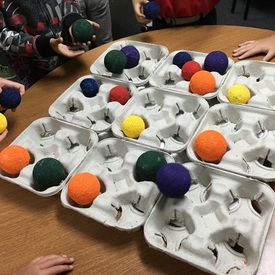Carnival
Tools and Materials:
Station 1: Pencils; erasers; sharpies to represent detail; watercolor or tempera paint, white construction paper, water, cups for water, brushes, and sponges
Station 2: Card stock paper, containers with assorted small bits of collage materials (yarn, paper, feathers, sequins, felt, etc.), scissors, glue, and staplers
Station 3: Air-dry clay, paper plates, clay tools (tongue depressors, old pencils, bottle caps, modeling/styling tool, etc) liquitex gloss medium, black sharpies
Introduction:
Review:
Process:
Station 1: Pencils; erasers; sharpies to represent detail; watercolor or tempera paint, white construction paper, water, cups for water, brushes, and sponges
Station 2: Card stock paper, containers with assorted small bits of collage materials (yarn, paper, feathers, sequins, felt, etc.), scissors, glue, and staplers
Station 3: Air-dry clay, paper plates, clay tools (tongue depressors, old pencils, bottle caps, modeling/styling tool, etc) liquitex gloss medium, black sharpies
Introduction:
Review:
- What makes a person creative?
- They think of new ideas
- They approach things in ways that are original to them
- They are inventive and resourceful
- They look at new possibilities to solving problems as they work on projects
- How can you develop your creativity?
- Do not worry what other people think about your work
- Do not be afraid—of rejection, of being different, of not doing it right, or of getting a bad grade
- Examine different ways of doing things
- If you don’t have what you need, think about what else you can use
- Try doing things a new way
- Take time to think about it; pray about it
- Talk about your ideas with someone else; get a second opinion
- Practice and look at things you are interested in, study them
- Why is it important to develop and use creativity?
- Creativity helps you express your thoughts and ideas
- It helps develop new ways of thinking and new ways to solve problems
- It helps build self-confidence
Process:
- Students enter Inspiration Area and play games designed to promote creative thinking
- After ten minutes, students will enter the Participation Area (the Art room) where three art centers are set up
- Students paint, sculpt, or create collages at the assemblage center
- Formative: Assessment is done through teacher observation of student’s participation and during informal interviews. Learners should be able to demonstrate a basic understanding of what creativity means and if they consider themselves creative.
- Summative: Individual artwork will be reviewed for thinking of new ideas, for approaching something in a way that is original to them, and for looking at new possibilities to solve problems that occur as they work.

